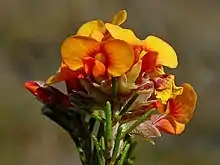| Dillwynia rudis | |
|---|---|
 | |
| At Green Cape | |
| Scientific classification | |
| Kingdom: | Plantae |
| Clade: | Tracheophytes |
| Clade: | Angiosperms |
| Clade: | Eudicots |
| Clade: | Rosids |
| Order: | Fabales |
| Family: | Fabaceae |
| Subfamily: | Faboideae |
| Genus: | Dillwynia |
| Species: | D. rudis |
| Binomial name | |
| Dillwynia rudis | |
| Synonyms[1] | |
| |
Dillwynia rudis is a species of flowering plant in the family Fabaceae and is endemic to eastern New South Wales. It is an erect shrub with warty, linear leaves and yellow to orange flowers with red veins.
Description
Dillwynia rudis is an erect shrub that typically grows to a height of 0.15–1.5 m (5.9 in – 4 ft 11.1 in), its stems densely covered with flattened hairs. The leaves are warty, linear, more or less glabrous and 8–18 mm (0.31–0.71 in) long. The flowers are usually arranged in pairs in leaf axils and are more or less sessile, with bracts 1–3 mm (0.039–0.118 in) long. The sepals are 4–7 mm (0.16–0.28 in) long and the standard petal is yellow to orange with red veins, 3–5 mm (0.12–0.20 in) long but much broader. The fruit is a pod 3–6 mm (0.12–0.24 in) long.[2][3]
Taxonomy and naming
Dillwynia rudis was first formally described in 1825 by Augustin Pyramus de Candolle in his Prodromus Systematis Naturalis Regni Vegetabilis from an unpublished description by Franz Sieber.[4][5] The specific epithet (rudis) means "rough" or "wild".[6]
Distribution and habitat
This dillwynia grows in heath and woodland between the Sydney region and the Goulburn River area and south along the coast and ranges of New South Wales.[2]
References
- 1 2 "Dillwynia rudis". Australian Plant Census. Retrieved 13 June 2021.
- 1 2 "Dillwynia rudis". Royal Botanic Garden Sydney. Retrieved 13 June 2021.
- ↑ Wood, Betty. "Dillwynia rudis". Lucid Keys. Retrieved 13 June 2021.
- ↑ "Dillwynia rudis". APNI. Retrieved 13 June 2021.
- ↑ de Candolle, Augustin P. (1825). Prodromus Systematis Naturalis Regni Vegetabilis. Vol. 2. Paris. p. 109. Retrieved 13 June 2021.
- ↑ Sharr, Francis Aubi; George, Alex (2019). Western Australian Plant Names and Their Meanings (3rd ed.). Kardinya, WA: Four Gables Press. p. 298. ISBN 9780958034180.